But this ever-changing digital landscape can quickly become overwhelming. I've put together this guide — with a free template — to help you efficiently create, fine-tune, and maintain an agile digital marketing strategy and improve your digital presence.
Table of Contents
- Marketing Strategies vs. Marketing Tactics
- Components of a Digital Strategy
- What is a digital marketing campaign?
- Digital Marketing Strategy Template
- Digital Marketing Campaign Examples
- Digital Strategy Examples
- Building My Own Strategy
Marketing Strategies vs. Marketing Tactics
Are you confused about the difference between a marketing strategy and marketing tactics?
You can think about it like this: strategy is planning, and tactic is doing. Having a strategy without ways to act on it (tactics) is daydreaming, and taking actions with no common goal or plan (strategy) wastes your time.
Let's dive a bit deeper into the differences between the two.
Characteristics of a Strategy
Marketing or not, there are three parts to any strategy:
1. A diagnosis of your challenge.
2. A guiding policy for dealing with the challenge.
3. A set of targeted actions is necessary to accomplish the policy.
Depending on the scale of your business, your marketing strategy may include several moving parts, each with different goals. With that said, working on your strategy can become daunting at times.
So, if you're ever feeling overwhelmed about your marketing strategy, refer to these three steps to keep you focused on achieving your objectives.
Characteristics of a Tactic
While strategies provide a framework for your overall vision, tactics determine the specific steps taken to execute that vision.
A good tactic should:
- Be specific, actionable, and measurable.
- Align with the overall strategy.
- Have a relatively short timeframe.
Depending on your marketing strategy, your tactics may include email marketing campaigns, publishing a blog, or organizing an event.
Now, let's look at digital marketing strategy.
A strong digital marketing strategy helps your business achieve specific digital goals through carefully selected mediums.
Similar to marketing strategies versus marketing tactics, “digital marketing strategy” and “digital marketing campaign” are also often used interchangeably. So, how do they differ?
I’ll discuss that in the following sections.
Components of a Digital Strategy
Goals and Objectives
First of all, you’ve got to lay out your main goals and specific objectives to build an effective digital strategy.
Goals are big-picture ideas, while objectives are more detailed and easier to measure. They have clear deadlines and show what success looks like.
Here is an example of how I like to think about the difference:
- Goal: To increase brand awareness.
- Objective: Grow social media following by 20% within the next quarter.
See the difference? When it comes to goals, you can define and measure them through SMART goals and criteria.
Audience Analysis
Next step — get to know your audience.
Research and identify the specific groups of people you want to reach.
Consider their age, where they live, and how much money they make. What are their interests? What issues do they face? Where do they spend their time online?
Study their online behavior, preferred websites, and what they like to read or watch, so you can pick the best platforms and make content that grabs their attention.
Pro tip: Take it further with Customer Profiling in 10 Easy Steps [+ Templates]
Content Plan
A content plan is the most interesting and, at the same time, most challenging part of any strategy.
Your content must inform, entertain, and engage.
Here you need to “spy” on your audience again. What kind of content do they devour? Where do they leave the most comments, likes, and shares? When do they mostly check in (morning, lunch, bedtime)?
Here are my top tips for creating a content strategy that works:
- Content variety. Use blog posts, videos, infographics, and more content formats to keep your audience engaged. Unique research and case studies are also great.
- Content pillars. Build content around core ideas that resonate with your brand and audience.
- Content calendar. Use a content calendar to stay consistent and ensure a steady flow of material.
- SEO. Research keywords and sprinkle them in for better online visibility.
- Content repurposing. Turn successful content into new formats to maximize its reach.
- Tracking and adapting. Use Google Analytics data to see what works and adjust your strategy accordingly.
Pro tip: Take your content strategy to the next level with this handy guide: How to Develop a Content Strategy in 7 Steps: A Start-to-Finish Guide
UX Design
Every digital strategy should prioritize a good user experience. Your site or app needs to be functional, enjoyable, and easy to use.
It must be clear, intuitive, and frustration-free. Otherwise, you risk losing potential customers.
Here are my tips for good UX:
- Clear navigation. Make the menu simple so customers can find what they need easily.
- Simple forms. Keep forms short with clear instructions and no annoying error messages.
- Mobile-friendly design. Your site must look good and work well on any device.
- Fast loading speed. Speed up your site to keep visitors and improve user experience.
Pro tip: Explore more UX design with our article Perfecting Your Digital UX Design — The Tips You Need to Know
Data Analytics
Data analytics track traffic, analyze which parts of the campaign resonate most, and even pinpoint where users might be dropping off.
Data analytics can also track how users behave, understand what they like, and even predict future trends.
Managing data analytics can be overwhelming, but HubSpot's Marketing Analytics & Dashboard Software makes it easy to keep track of all your marketing efforts effortlessly.
This lets you identify what‘s working and what’s not. You can then refine your approach, optimize content for better conversions, and ultimately achieve your objectives with laser focus.
Pro tip: If you want to learn more about data analytics, I recommend exploring our free guide to data analytics.
What is a digital marketing campaign?
Digital marketing campaigns are the building blocks and actions within your digital marketing strategy that move you toward a specific end goal.
For instance, if the overarching goal of my digital marketing strategy is to generate more leads through social media, I might run a digital marketing campaign on the social platform X.
I‘d share some of my business’s best-performing gated content on the platform to generate more leads through the channel.
Let's tie it all together to help you create a digital marketing strategy you execute with your digital marketing campaigns.
1. Build your buyer personas.
For any marketing strategy — digital or not — you need to know who you're marketing to. The best digital marketing strategies are built upon detailed buyer personas; creating them is your first step.
Featured Resource: Organize your audience segments and strengthen your marketing with these templates to build your buyer personas. They'll help you organize your insights and have a clear visualization of your target audience.
Buyer personas represent your ideal customer(s) and can be created by researching, surveying, and interviewing your business's target audience.
I have to note that it’s important that the information you gather is based on real data whenever possible. Making assumptions about your audience can cause your marketing strategy to go wrong.
Buyer personas are especially helpful if you have a niche audience. For example, I run Breaking the Blueprint, a HubSpot Blog column for minority business owners and entrepreneurs — a more specific group than the general HubSpot audience.
I could publish content based on what I think they might look for and benefit from, but I’m much more effective, impactful, and helpful if I dig deep and uncover their specific interests, needs, and challenges.
To get a well-rounded picture of your persona, your research pool should include customers, prospects, and people outside your contacts database who align with your target audience.
But what information should you gather for your buyer persona(s) to inform your digital marketing strategy?
That depends on your business — it’s likely to vary by whether you’re B2B or B2C or sell a high-cost or low-cost product.
I’ve outlined some starting points that you can fine-tune and tailor to your particular business:
Quantitative and Demographic Information
- Location: Use web analytics tools to easily identify what location your website traffic is coming from.
- Age: Depending on your business, this may or may not be relevant information. But if it is, it's best to gather this data by identifying trends in your existing prospect and contact database.
- Income: It's best to gather sensitive information like personal income through persona research interviews, as people might be unwilling to share these details via online forms.
- Job Title: This is something you can get a rough idea of from your existing customer base and is most relevant for B2B companies.
- Goals: Depending on what challenge your product or service solves, you may already have a good idea of the goals of your buyer persona. Cement your assumptions by speaking to real customers and internal sales and customer service reps.
- Challenges: Speak to customers, sales and customer service reps, and any other customer-facing employees to get an idea of the common challenges your audience members face.
- Hobbies/Interests: Ask customers and those who align with your target audience about their hobbies and interests. If you’re a fashion brand, for example, it’s helpful to know if large segments of your audience are also interested in fitness and well-being to inform future content and partnerships.
- Priorities: Talk to customers and target audience members to find out what‘s most important to them in relation to your business. For example, if you’re a B2B software company, knowing your audience values customer support over a competitive price point is very valuable information.
By combining all of these details, you'll be able to create buyer personas that are accurate and highly valuable for your business.
2. Identify your goals and the digital marketing tools you'll need.
Your marketing goals should always be tied back to the fundamental goals of your business.
For example, if my business’ goal is to increase online revenue by 20%, my marketing team’s goal might be to generate 50% more leads via the website than the previous year to contribute to that success.
My pro tip: I recommend using a high-level marketing plan template to outline your annual marketing strategy, identify top priorities, and more.
Whatever your overarching digital marketing goal is, you must be able to measure the success of your strategy along the way with the right digital marketing tools.
For instance, HubSpot's Reporting Dashboard brings all of your marketing and sales data into one place, so you can quickly determine what works and what doesn't to improve your strategy for the future.
My favorite feature is that you can customize your dashboards with the drag-and-drop editor to ensure your reports feature the metrics that matter most.
3. Evaluate your existing digital channels and assets.
When reviewing your existing digital marketing channels and assets to determine what to incorporate in your strategy, it's helpful to first consider the big picture — this will prevent you from feeling overwhelmed or confused.
Gather what you have and categorize each vehicle or asset in a spreadsheet so you have a clear picture of your existing owned, earned, and paid media.
Owned, Earned, Paid Media Framework
To do this effectively, I recommend using the owned, earned, and paid media framework to categorize the digital “vehicles,” assets, or channels you‘re already using and decide what’s a good fit for your strategy.
Owned media refers to the digital assets your brand or company owns, like your website, social media profiles, blog content, or imagery.
Owned channels are what your business has complete control over. The HubSpot Blog is an example of owned media, but this can also include some off-site content you own (e.g., a blog you publish on Medium).
Earned media, also called earned content, is anything written about or created about your business that doesn’t come from paid advertising or sponsorships.
It’s published by a third party, like press mentions or media outlet coverage, people sharing your content via their networks, user-generated content, and even word-of-mouth marketing from satisfied customers.
You can earn media by getting press mentions and positive reviews as well as by people sharing your content via their networks (e.g. social media channels).
Paid media refers to any vehicle or channel you spend money on to catch the attention of your buyer personas.
This includes things like Google Ads, paid social media posts, native advertising (e.g. sponsored posts on other websites), or any other medium through which you pay in exchange for increased visibility.
I’ll go over an example now that I’ve outlined the framework.
Owned, Earned, and Paid Media Framework Example
Say I have an owned piece of content on a landing page on my website that's been created to help me generate leads.
I know I want to incorporate different parts of the framework rather than just working with owned, earned, or paid media alone.
To amplify the number of leads the content generates, I ensure it's shareable so my audience can distribute it via their social media profiles. In return, this will increase traffic to my landing page. This is the earned media component.
To support my content's success, I might post about the content on my Facebook page and pay to have it seen by more people in my target audience.
This is how the three parts of the framework can work together, although it's not necessary for success. For instance, if my owned and earned media are already both successful, I might not need to invest in paid methods.
I recommend evaluating what solution will help you best meet your goals and then incorporating those channels into your digital marketing strategy.
Featured Resource: Keep track of your paid media efforts with HubSpot's free Paid Media Template.
4. Audit and plan your owned media campaigns.
At the heart of digital marketing is owned media — and it almost always comes in the form of content.
That’s because nearly every message your brand broadcasts can be classified as content, whether it’s an About Us site page, product descriptions, blog posts, ebooks, infographics, podcasts, or social media posts.
Content helps convert your website visitors into leads and customers while improving your brand’s online presence. And when this content is search engine optimized, it can boost your search and organic traffic.
Whatever your digital marketing strategy goal is, you'll want to incorporate owned content. To start, decide what content will help you reach your goals.
Continuing with the example from above, my goal is to generate 50% more leads on my website this year. My About Us page is probably useless to my strategy unless it’s somehow been a lead-generation machine in the past.
If you’re feeling stuck, below I’ve outlined a brief process you can follow to work out what owned content you need to meet your digital marketing strategy goals.
Audit your existing content.
I promise marketing audits are significantly less scary than any other type of audit and much simpler.
Just make a list of your existing owned content, then rank each item according to what has previously performed best concerning your current goals.
For example, if your goal is lead generation, rank your content according to which pieces generated the most leads over the last year (such as a blog post, ebook, or site page).
The idea here is to figure out what’s currently working, and what’s not so that you can set yourself up for success when planning future content.
Identify gaps in your existing content.
Based on your buyer personas, identify any gaps in the content you have.
For example, if you're a math tutoring company and know through research that a major challenge for your personas is finding effective ways to study, create some.
By looking at your content audit, you might discover that ebooks hosted on a certain type of landing page convert really well (better than webinars, for example).
In the case of this math tutoring company, you might make the decision to add an ebook about “how to make studying more effective” to your content creation plans.
Create a content creation plan.
Based on your findings and the gaps you’ve identified, make a content creation plan outlining the content that’s necessary to help you hit your goals.
This should include:
- A title.
- Format.
- A goal.
- Promotional channels.
- Why you're creating the content.
- The priority level of the content.
This can be a simple spreadsheet and should also include budget information if you‘re planning to outsource the content creation or a time estimate if you’re producing it yourself.
5. Audit and plan your earned media campaigns.
Evaluating your previous earned media against your current goals can help you get an idea of where to focus your time.
Look at where your traffic and leads are coming from (if that's your goal) and rank each earned media source from most effective to least effective.
You can obtain this information using tools like the Sources reports in HubSpot's Traffic Analytics tool.
You may find a particular article you contributed to the industry press drove a lot of qualified traffic to your website, which boosted conversions.
Or, you may discover that LinkedIn is where you see most people sharing content, which increases traffic.
The idea is to build a picture of what types of earned media will help you reach your goals (and what won’t) based on historical data.
However, if there’s something new you want to experiment with, don’t rule it out just because it’s never been done before.
6. Audit and plan your paid media campaigns.
Auditing your paid media campaigns (also a simple, no-frills audit) is the same process: evaluate your existing paid media across each platform (e.g. Google Ads, Facebook, X, etc.) and identify what’s most likely to help you meet your current goals.
Say, for example, you spend a lot of money on ads and find that you don’t get the results you’d hoped for. It might be time to refine your approach or scrap it all together and focus on another platform that yields better results.
Featured Resource: Use this Google Ads PPC Kit to learn how to leverage Google Ads for your digital marketing strategy.
By the end of the process, you should have a clear idea of which paid media platforms you want to continue using and which (if any) you'd like to remove from your strategy.
7. Bring your digital marketing campaign together.
You've done the planning and the research, and you now have a solid vision of the elements that will make up your digital marketing strategy.
To review, here's what you should have solidified so far:
- Clear profile(s) of your buyer persona(s).
- One or more digital marketing-specific goals.
- An inventory of your existing owned, earned, and paid media.
- An audit of your existing owned, earned, and paid media.
- An owned content creation plan or wish list.
Now, you bring all of your findings together to plan the campaign(s) that will make up your digital marketing strategy.
A better understanding of digital marketing strategies is vital to your ultimate success. Earning a bachelor’s in marketing or a related field can be valuable and boost your career.
In the meantime, I made a list of basic marketing strategies commonly used by teams across various industries.
To make it even more helpful, I used our 2025 State of Marketing Report to order the list based on what marketers use most and find the most effective.
Digital marketing isn’t one size fits all. Each business has its own unique needs and goals. Therefore, every marketing team will have their own approach.
However, there are many online marketing strategies that you can implement to spread awareness about your business and attract new customers.
Here are some common, effective strategies that can help you build a comprehensive digital marketing plan.
1. Content Marketing
Content marketing involves creating and sharing valuable, relevant, and consistent content to attract and engage your target audience. Instead of bombarding your audience with ads and promotional messages, content marketing focuses on providing your customers with information that is interesting and useful to them.
Ultimately, the goal of content marketing is to build trust, establish thought leadership, and drive profitable customer action.
There are two major trends in content marketing we’re seeing in 2025: Visual storytelling and value-driven content.
Visual Storytelling is the New Norm
Short-form video, images, and live-streaming video were among the most commonly used — and highest ROI — content formats in 2024, and our research shows that marketers are increasing their investment in these visual storytelling formats in 2025.
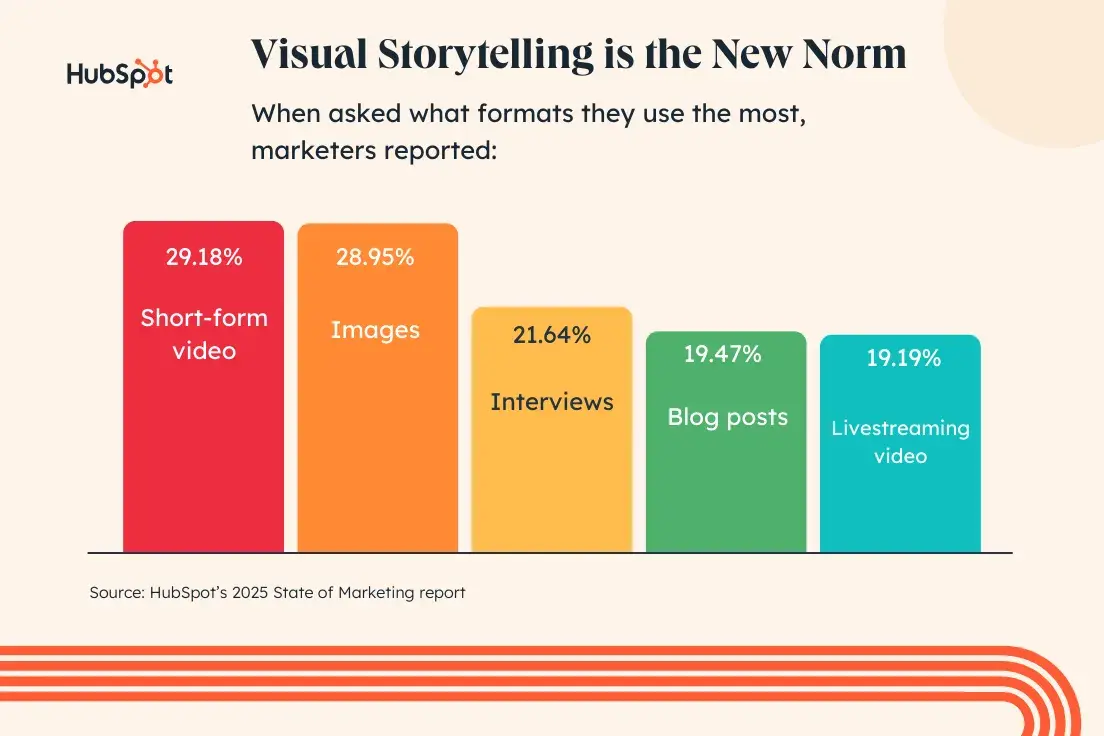
This increase is partly because marketers are shifting their focus to younger audiences.
Brands are Increasingly Value-Driven
Younger customers are also more likely to seek out brands whose values align with their own. Content marketers are meeting that demand by creating more content that reflects their brand’s values — 21% of respondents said they’re exploring this trend in 2025.
Brand-led marketing strategies in general are increasing in popularity, as marketers zero in on brand awareness and their customers’ experiences with their brand.

Since buyers view around three to five pieces of content before engaging with a sales rep, content marketing is how you give them what they’re looking for. And although we’re seeing a smaller proportion of marketers who are putting more resources toward blogging, 15% still told us that they’re increasing their investment in 2025.
Blogging is a major play for businesses that want to attract customers who are genuinely interested in their products and services. And well-written, well-researched blog posts often answer an urgent need for a potential customer.
For instance, HubSpot sells marketing software, and our users are typically marketing professionals who create plans, campaigns, and editorial calendars for their employers.
Recognizing this, Hubspot offers a free blog maker to help you get started on publishing content that resonates with your audience, ensuring you can easily share your knowledge and insights without the technical hassle.
The key is not to blog just because: Blog with the intent to solve for the customer. To effectively do so, it’s important to understand your target audience and their pain points.
That way, you can write highly targeted content that’s genuinely helpful for readers, especially since consumers say they read between one and four blog posts per month.
Online Marketing Benefits of Content Marketing
- Boosts web traffic: Regularly publishing fresh and relevant blog content can improve your SEO rankings, attracting more organic visitors to your website. Plus, sharing content on your social media pages and other channels can help you stay engaged with your audience while increasing visibility.
- Establishes authority and credibility: Sharing your expertise and insights through blog articles and other content can help establish you and your company as a thought leader in your industry. This also allows you to engage with your audience and provide them with useful information that speaks to their pain points. Not only does this build trust, but it also positions you as a reliable and knowledgeable resource.
- Generates leads and conversions: By creating engaging and relevant content, you can attract potential customers who are interested in your business and move them through the buyer’s journey. You can also convert readers into leads by including CTAs that encourage readers to take action, such as subscribing to a newsletter or registering for a free trial.
Recommended Reading
- Why Blog? The Benefits of Blogging for Business and Marketing
- How to Create a Successful Blog Strategy: A Step-by-Step Guide
- Blog SEO: How to Search Engine Optimize Your Blog Content
- Blogging Mistakes to Avoid According to HubSpot Bloggers
2. Influencer Marketing
The global market for influencer marketing has quadrupled since 2019, and we’re seeing a particular rise in niche-influencer marketing in 2025.
By partnering with influencers, brands can create content that promotes their products or services while leveraging the influencer’s reach.
There are many ways you can partner with influencers, such as sponsored content, guest blogging, product collaborations, influencer takeovers, and more.
Before partnering with an influencer, it’s important to do your research and make sure they have an engaged following within your industry or niche and are aligned with your values and messaging.
Not sure how to get started? Check out HubSpot’s Ultimate Guide to Influencer Marketing.
Featured Resource: The Ultimate Guide to Influencer Marketing
Influencer marketing might seem unattainable from a cost perspective, as most businesses don’t have A-list budgets. But as Eric Munn, the director of marketing for the Chicago Transit Authority who was featured in our Masters in Marketing newsletter, points out, local and regional influencers can be quite affordable and have valuable audiences.
“Our campaign was focused on using the CTA because it saves you money, which means more money in your pocket to go do all of the things that Chicago has to offer.” So Munn turned to Chicagoland influencers who make videos with themes like “five things to do in Chicago this weekend” or “Chicago’s hidden gems.”
Followers of those influencers were very likely to be in the CTA’s target audience already, making it a valuable marketing play — but without paying national influencer prices.
Many marketers prefer working with niche influencers and find them the most effective, which makes sense — the cost is lower, and these influencers typically have a stronger bond with a smaller and more engaged community, ready and open to hear from them.
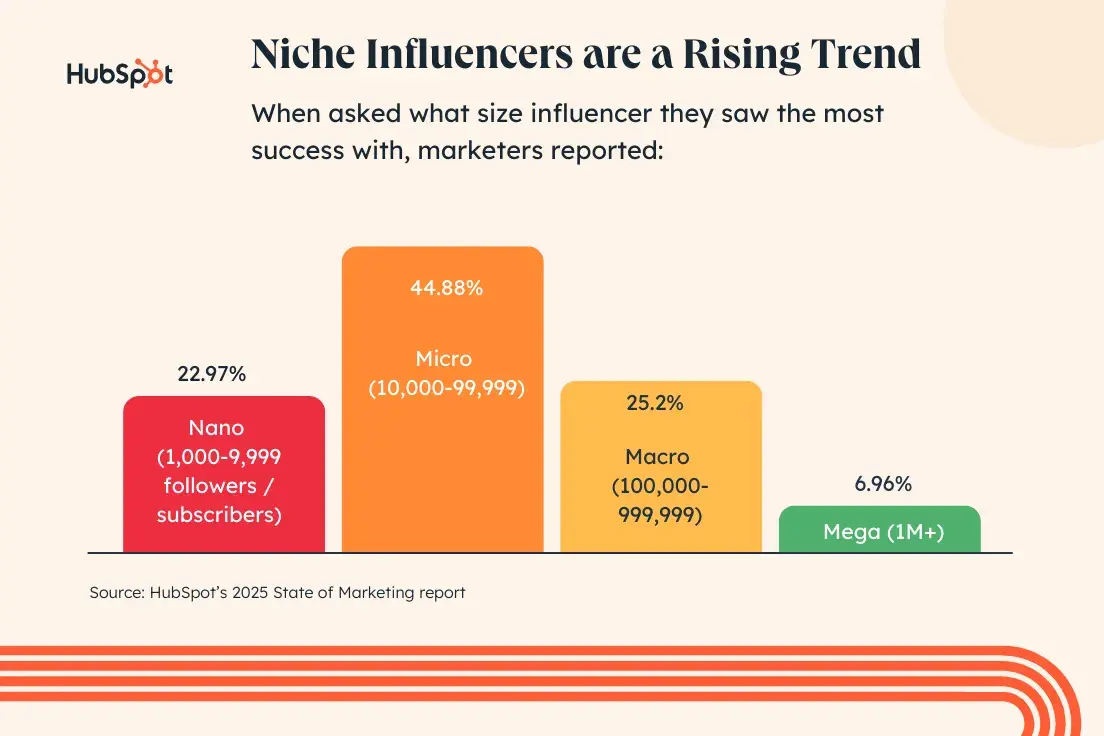
Online Marketing Benefits of Influencer Marketing
- Brand exposure: Partnering with influencers allows you to tap into the influencer’s existing audience and reach, which can significantly boost your brand’s awareness. By leveraging an influencer’s platform and following, you can expose your products or services to a larger audience and gain visibility among potential new customers.
- Authentic content creation: Influencers are skilled in creating engaging and authentic content that resonates with their followers. By partnering with influencers, you can tap into their creativity and expertise to develop compelling content that promotes your brand’s offerings in an organic and relatable manner. Plus, user-generated content created by influencers can showcase real-life experiences with your brand, which can influence buyer decisions and foster trust.
- Trust and credibility: Influencers are seen as trusted authorities within their niches. When they endorse or recommend a brand’s products or services, it adds credibility and trust. This can positively influence consumer perceptions and increase the likelihood of potential customers trying or purchasing from your brand.
Recommended Reading
- Influencer Marketing Strategy: How to Build a Plan Creators & Customers Will Love [+ Templates]
- 13 Influencer Marketing Campaigns to Inspire and Get You Started With Your Own
- The Top Channels for Influencer Marketing
3. Social Media Marketing
Social media marketing is another way to generate brand awareness online and boost your digital strategy.
It involves creating and sharing content on social media platforms, such as Facebook, Instagram, X, and others, to attract attention, drive website traffic, and generate leads.
Visual storytelling is a natural fit for social media. In 2024, short-form video, images, and livestreaming video were among the most commonly used content, and we’re only seeing that trend accelerate.
Heading into 2025, all three formats are seeing increased investment by a higher proportion of marketers than all other formats. Marketers are shifting their social media strategies to accommodate visually rich storytelling — and they’re hiring more social media pros at all levels.
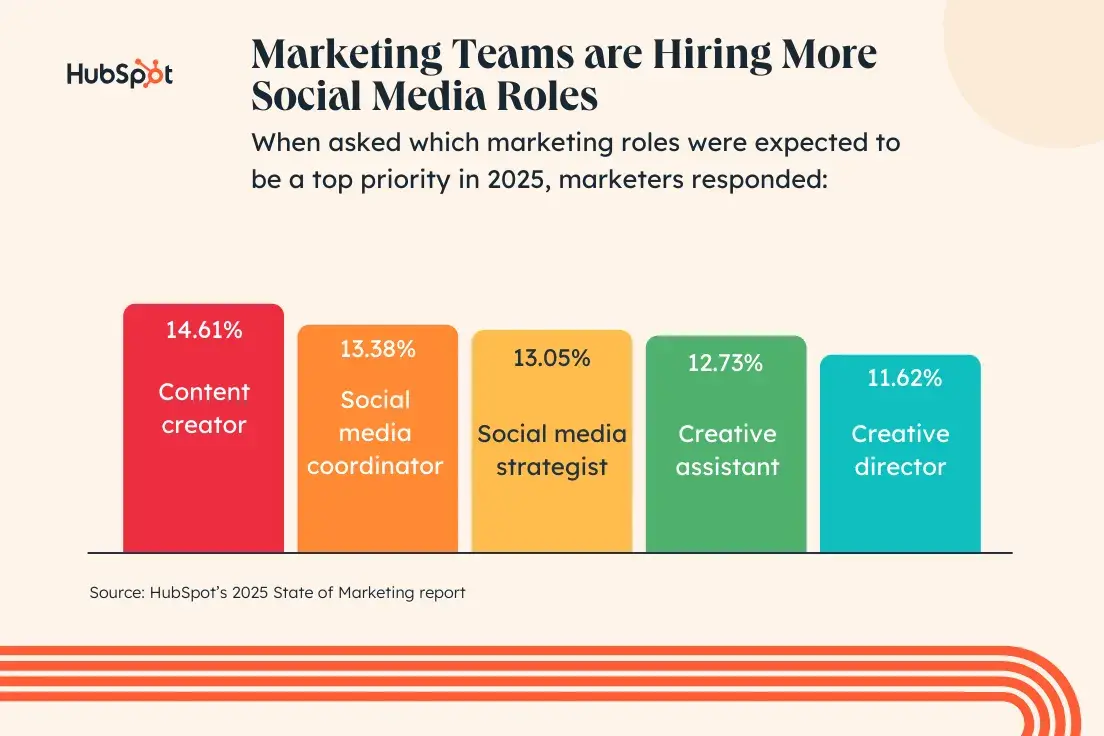
Social media marketing is also great for building communities around your brand.
You can speak directly to your audience, engage with followers through comments and messages, and have discussions to connect with them on a more personal level. According to our research, more and more marketing teams — 20% of the marketers we surveyed — are exploring using social media DMs for customer service.
The stronger your relationship with your audience, the more loyal they will be to your brand.
Online Marketing Benefits of Social Media Marketing
- Increases brand awareness: With billions of active social media users, you can reach a wide audience and increase your brand’s visibility. This is especially true if you participate in relevant social media trends, run paid campaigns, create and promote branded hashtags, and collaborate with other brands.
- Boosts engagement: A strong social media presence can help create a community around your brand and build a strong relationship with your followers. Plus, you can use tactics like contests and giveaways to encourage specific actions that support your marketing goals, such as asking users to tag a friend or write a review.
- Rich insights and analytics: Social media platforms typically provide robust analytics tools that allow you to measure the effectiveness of your marketing campaigns, track key metrics, and gain insights for continuous improvement.
Recommended Reading
- Social Media Marketing Mastery: How to Turn Likes into Loyal Customers
- How to Create a Great Social Media Strategy in 2025 (+New Data)
- The HubSpot Blog's 2025 Social Media Marketing Report: Data from 1400+ Global Marketers
- How to Run a Social Media Contest That Gets Tons of Engagement
- The Fastest Growing Social Media Platforms [New Data]
4. Paid Advertising
An organic content marketing strategy is only a portion of the story. It’s just as important to implement non-organic plays, such as paid advertising.
Not only will this help you drive more brand awareness, but it will also help you reach audiences who can’t find your business organically yet.
I recommend paid advertising if you’re still growing your blog or business and not getting as much traffic as you want. There are a few types of advertising you can consider adding to your digital strategy:
Nearly every platform has an option for you to advertise — either through a display network (such as Google’s) or through its built-in ad system (such as Instagram’s, Facebook’s, and LinkedIn’s self-serve advertising portal).
Here’s one example of an ad on LinkedIn:

What I like the most, and the biggest benefit of paid advertising, is that it’s not dependent on a content or SEO strategy where success can take a while to build.
You choose a platform, create your budget, write copy, decide on images, and launch your advertising campaigns.
Still, to ensure your success, I’d recommend creating an advertising plan that outlines who you’re targeting, which channels you’ll be using, and how much you plan to spend.
I recommend downloading the following template to create your plan.
Featured Resource: Advertising Plan Template
Online Marketing Benefits of Paid Advertising
- Targeted campaigns: Platforms like Google, Facebook, and Instagram enable you to target your ads to specific audiences based on their demographics, interests, behaviors, and more. This helps ensure that your ads are seen by the right people who are more likely to be interested in your products or services.
- Measurable results: No matter which platform you advertise on, you’ll be able to track the success of your ad campaigns by analyzing performance metrics such as impressions, clicks, and conversions. By analyzing this data, you can identify which ads and targeting strategies are most effective and make informed decisions to improve future campaigns.
- Flexibility: Paid advertising gives you the option to adjust your campaigns, targeting options, and budget based on your marketing goals and audience preferences. This can help you stay agile and responsive in the fast-moving digital marketing landscape and ensure that you are getting the most from your advertising budget.
5. Account-Based Marketing (ABM)
Account-based marketing is a strategic approach that focuses on targeting and engaging specific high-value accounts or key decision-makers within those accounts.
Rather than casting a wide net to reach a broad audience, ABM personalizes marketing efforts to cater to the needs and preferences of specific target accounts.
This strategy is particularly suitable for B2B organizations and industries with complex sales cycles, where forging strong relationships with specific key accounts is critical.
For instance, let’s say my software company wants to target enterprise account XYZ Inc.
Instead of a broad marketing approach, I adopt an ABM strategy and tailor my efforts to XYZ Inc. by researching its pain points and business objectives.
I’ll develop personalized content tailored to its needs, engage with decision-makers, nurture relationships, and coordinate my marketing and sales efforts. All of my marketing efforts focus on what works for this one account.
Since it has a specific use case, ABM is lower on the list of popular digital marketing strategies, and I don’t recommend it to anyone but B2B organizations or industries with high-value accounts and complex sales cycles.
Dustin Brackett, CEO and founder of HIVE Strategy, feels similarly, and says he believes in the power ABM has for some organizations but understands why it’s not a popular trend.
“ABM is really only valuable for organizations that have high-value customers. There isn't a ton of ROI to be had by investing in ABM for a B2C organization, or any organization that has a lower customer lifetime value because ABM is a large investment in time, resources, and dollars,” Brackett says.
Featured Resource: How to Implement an ABM Strategy
Online Marketing Benefits of Account-Based Marketing
- Personalized approach: Unlike other marketing strategies, ABM enables you to create tailor-made content, communications, and campaigns for each account you target. This level of personalization helps you establish stronger relationships with your target accounts and increase the likelihood of conversion.
- Alignment between marketing and sales: Alignment between your marketing and sales team is crucial for implementing a successful ABM strategy. It ensures that both teams are focused on the same goals and committed to creating consistent experiences for accounts.
- Improved customer retention: ABM emphasizes building long-term relationships with target accounts. By understanding their specific needs and providing relevant solutions, marketers can increase customer satisfaction, retention, and even drive further expansion within the account.
Recommended Reading
- 8 Steps to Build Your Account Based Marketing Strategy [+ Recommended Tools]
- How to Choose the Right Accounts for ABM, from HubSpot's ABM Product Manager
- Account-Based Marketing vs. Inbound Marketing
- The Best Account-Based Marketing Software
6. Search Engine Optimization (SEO)
SEO is the practice of optimizing your web content, structure, and technical aspects to improve its visibility and ranking on search engine results pages (SERPs).
The ultimate goal of SEO is to increase organic, non-paid traffic to your website from search engines like Google and Bing.
If your product pages aren’t earning traffic, SEO is your best bet to get those pages in front of those who are searching for those products and services.
To ensure that your content engages and converts users, it’s important to invest in an on-page SEO strategy.
According to our survey, B2B brands report that the top marketing channel resulting in ROI in 2024 was website, blog, and SEO. I’m not surprised by this because of my own experience.
More often than not, I’m looking to Google to find answers to my questions, and so are my other consumer peers — among all generations, people prefer to find answers to their questions with search engines.
And, while social search (which I’ll cover below) continues to gain steam, consumers still find the best answers on search engines.
AI chatbots, however, are gaining popularity — our 2025 survey named it as the top channel that brands are planning to use for the first time. Consider building up a solid presence in AI search results as soon as possible — before your competitors get ahead of the curve.
An AI Search Grader lets you gauge your brand’s — and competitors’ — visibility across AI-powered search engines, along with popular search results related to your industry or company. You can use these details to gain more control over what type of information chatbots pull from your website, guide them to show accurate results, and create more relevant content.
Online Marketing Benefits of SEO
- Increases organic traffic: Optimizing your digital content for search engines can help you rank higher in search engine results pages (SERPs) for relevant keywords that your audience is using. As your ranking increases, so does your brand’s visibility and your website’s organic traffic.
- Improves user experience: When it comes to getting higher rankings, optimizing your website for users is just as important as optimizing for search engines. This includes ensuring that your website is easy to navigate and has a clear hierarchy of information so users can quickly find what they are looking for. In doing this, you not only improve the user experience, but you also increase the chances of users staying on your website longer, engaging with your brand, and ultimately, becoming customers.
- Provides long-term benefits: Unlike paid advertising, which requires ongoing investment, optimizing your content for search engines can provide long-term benefits by driving consistent and ongoing organic traffic to your website. Yes, it can take longer to reach your goals, but the payoff includes saving your business money and building an authentic brand reputation.
Recommended Reading
- Improve Your SEO with These Best Practices and Expert Resources
- How to Create an SEO Strategy
- How to Do Keyword Research for SEO
7. Podcasting
In 2019, just 32% of Americans had listened to a podcast within the last month. In 2024, that jumped to 47% — that’s nearly half of American adults who have their headphones on and are looking for great audio content.
Although it’s not as popular as some forms of content marketing, 13% of surveyed marketers told us that they were increasing their investment in podcasting in 2025.
Dan Stillgoe, Blend’s Marketing Manager, spoke to my colleague Caroline Forsey and told her the same thing.
He says, “It‘s true that you can’t directly attribute leads or revenue from a podcast, but that's not its purpose."
Podcasts are a long-term brand-building channel that can improve affinity and connection for your brand like no other channel,“ he explains. ”When you realize the long-term and surrounding benefits, podcasting becomes a clear and obvious investment.”
He adds, “Podcasting is the perfect way to craft content that's engaging and authentic — something buyers are beginning to crave in this AI era.”
For inspiration, check out the HubSpot Podcast Network:
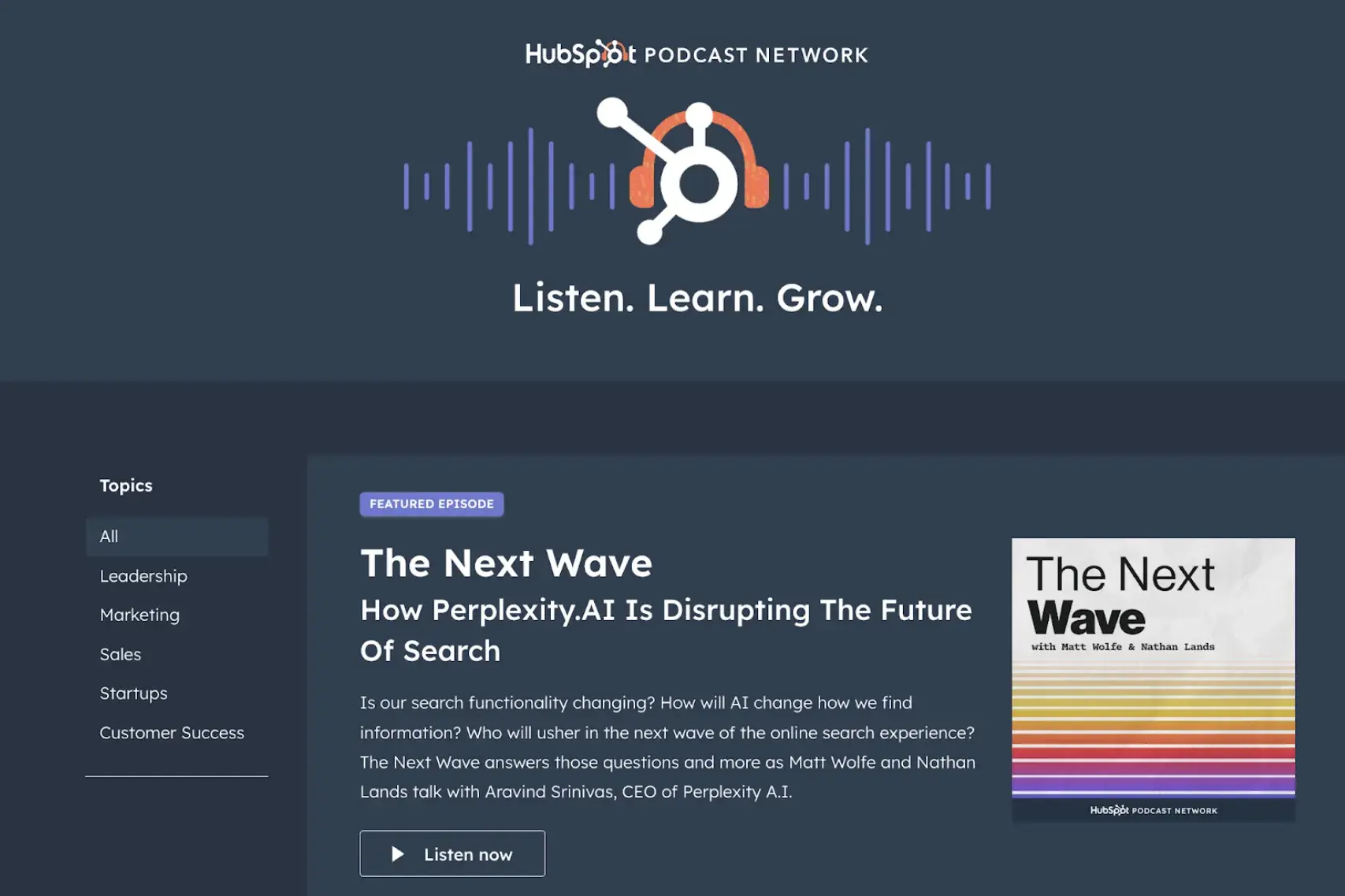
Instead of looking to podcasts to drive exponential ROI, I recommend leveraging them to drive engagement.
Having podcasts in your digital strategy allows you to reach people on platforms other than search engines and social media channels, and it’s a much more unplanned, natural medium — though, of course, you should plan each episode carefully and ensure you’re delivering contact that actually serves your listeners.
As a consumer, I like the authenticity of podcasts and how they feel like a free-flowing conversation. I even pay for premium membership subscriptions to some of my favorite shows to take advantage of extra content.
Featured Resource: How to Start a Podcast
Online Marketing Benefits of Podcasting
- Discoverability: Podcasts can be hosted on various platforms, such as Spotify, Apple Podcasts, and Stitcher, expanding your brand’s reach. You can also transcribe your podcasts and publish the transcript to make them more SEO-friendly. Plus, you can invite guests to speak on your podcast and have them share the episode with their followers.
- Authenticity: Podcasting allows for a more conversational tone compared to other forms of content. The audio format lends itself to authentic and unscripted conversations, creating a sense of connection and genuine interaction between you and your listeners.
- Sustainable: Podcasts have a long shelf life and can remain relevant for months to come, helping you get the most out of your content. Plus, you can repurpose the audio material to create blog posts, videos, ebooks, and other types of content.
Recommended Reading
- Podcasting: What You Need + Nine Steps To Get Started
- 3 Tips on Launching a Kickass Podcast, from My First Million Producers
- The Anatomy of a Perfect Podcast Episode, According to HubSpot's Podcast Expert
- How to Optimize Your Podcast Audio for Search (Like HubSpot's Podcast Expert)
8. Email Marketing
Email marketing is still one of the most leveraged channels among marketers and offers the second-highest ROI for B2C brands.
It gives you plenty of opportunity to nurture customers who are highly interested in your products. It’s important, however, to only email those who have opted-in to receive emails from you.
It’s bad form — and illegal, for that matter — to do otherwise, and it risks diminishing your email deliverability.
You can earn subscribers through your blog, contests, and even through webinars.
Any time someone gives you their email — and every time they give consent to receive communication from you — you have full permission to target them with an email marketing campaign.
Featured Resource: Email Marketing Planning Template
Online Marketing Benefits of Email Marketing
- Builds relationships: Email allows you to communicate directly with your audience, establishing a personal relationship and building trust over time. You can also customize email campaigns to the interests and unique preferences of your target audience, providing more content that is relevant to their needs. Fun fact: Segmented and personalized emails drive 30% more opens and 50% more click-throughs.
- Drives traffic to your website: Emails with links to your website or blog can drive traffic to your website and engage with your brand. You can even send your email subscribers exclusive deals, promotions, or discounts, which can increase the potential for conversions.
- Easy to track: Email marketing campaigns can be tracked and measured, providing valuable insights such as open rates, click-through rates, conversion rates, bounce rates, and unsubscribe rates. By analyzing these metrics, you can make data-driven decisions that can help you reach your target audience more effectively.
My pro tip: Streamline your email marketing efforts with generative AI, as marketers told us it’s the most effective at creating emails.
Try it for yourself with AI Email Writer, HubSpot’s generative AI tool that will help you automate copywriting and create marketing emails that capture attention and inspire clicks.
Recommended Reading
- 16 Email Marketing Benefits Your Marketing Team Must Know
- How to Launch a Successful Email Marketing Campaign: Tips + Data from an Email Marketer
- Examples of Brilliant Email Marketing Campaigns
9. Video Marketing
With platforms like TikTok and Instagram Reels on the rise, video marketing is more popular — and effective — than ever. Even with the will-they/won’t-they TikTok ban, 27.64% of surveyed marketers said they’re increasing their investments in the platform in 2025, only slightly trailing YouTube (29.58%) and Instagram (28.84%).
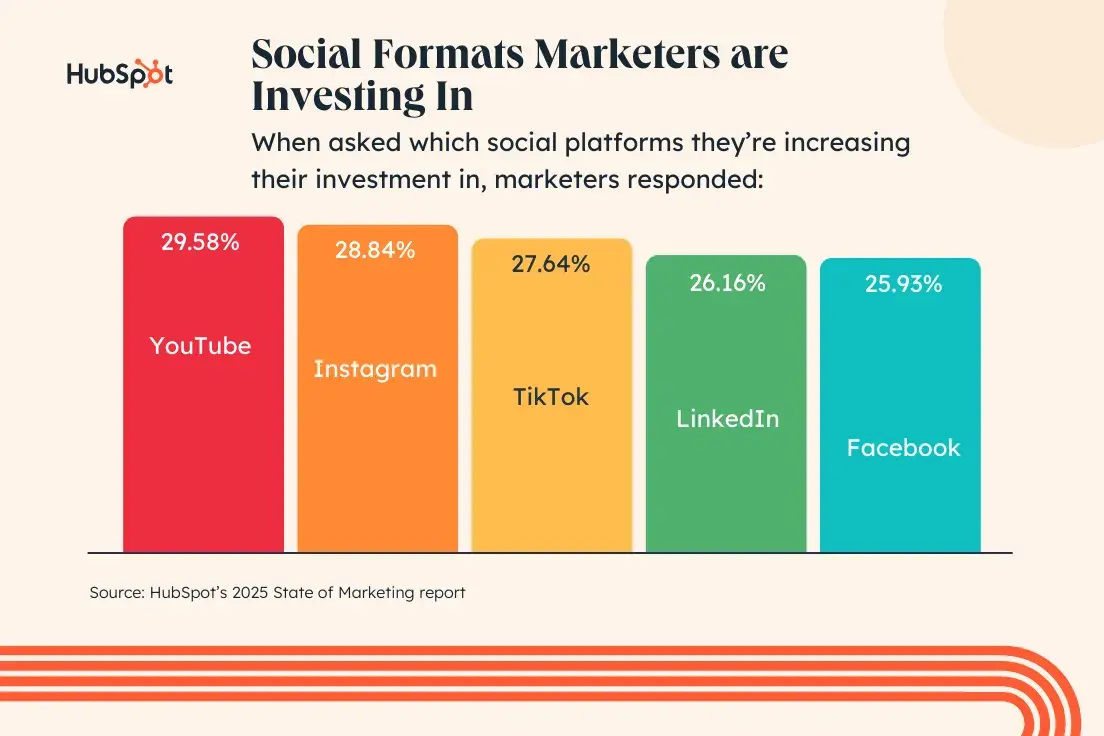
One of the reasons videos are so effective is because they allow you to communicate with your audience in a more personal way. And with the aforementioned shift toward visual storytelling, it makes sense to put some resources behind video marketing, particularly if your target audience is on the younger side.
Plus, short-form video takes less bandwidth and effort to create, you can still share a lot of information, and shorter videos align with the fast-paced attention span of many watchers.
By making video an integral part of your digital strategy, you’re able to showcase your brand’s creativity and explore more content formats, such as product demos, explainer videos, expert interviews, customer testimonials, and more.
Online Marketing Benefits of Video Marketing
- Boosts SEO: Since Google tends to prioritize video content in its search results, implementing video as part of your marketing strategy can improve your search engine visibility. Plus, video content can be optimized with relevant titles, descriptions, and keywords, making it easier for search engines to understand and categorize the content.
- Better retention: Video is easier to remember than text-based content because it allows you to use storytelling techniques and communicate important messages more effectively. Video has the power to invoke emotions and create a connection with your audience, making it easier for them to consume and remember your content.
- Enhances reach: Video is highly shareable on social media due to its easily digestible nature. As people share your video content with their own social media networks, it exposes your brand to new audiences.
Recommended Reading
- Video Tips and Data, According to Video Marketers
- The Best Video Marketing Channels to Grow Your Brand
- The Video Marketing Playbook
Now, it’s time to bring all of this together to form a cohesive marketing strategy document. Your strategy document should map out the series of actions you’re going to take to achieve your goals based on your research up to this point.
Let's discuss how our digital strategy template can help.
Digital Marketing Strategy Template
While a spreadsheet can be an efficient format for mapping your digital marketing strategy, that approach can quickly become messy and overwhelming.
To plan your strategy for the long-term — typically between six to 12 months out, I recommend a reliable digital marketing strategy document. But where to start? With our free digital marketing plan template.
This template will walk you through your business summary and initiatives, help you build your target market and competitor information, and flesh out your marketing strategy — including your budget and specific channels and metrics.
Use this digital strategy template to build out your annual digital marketing strategy and tactics. By planning out these yearly plans, you can overlay when you and your team will be executing each action. For example:
- In January, you'll start a blog that will be continually updated once a week for the entire year.
- In March, you'll launch a new ebook, accompanied by paid promotion.
- In July, you'll prepare for your biggest business month — what do you hope to have observed at this point that will influence the content you produce to support it?
- In September, you'll focus on earned media in the form of PR to drive additional traffic during the run-up.
This approach provides a structured timeline for your activity which will help communicate plans among colleagues.
Finally, here are some examples of digital marketing campaigns and their strategies to inspire you.
Digital Marketing Campaign Examples
1. Béis: Paid Ad
Travel accessory brand Béis ran a social media campaign to announce feature updates to one of its products. And they did it in the best way: by showing instead of telling.

Why I like this: In a 34-second clip distributed on Instagram Stories, the brand shows how its product performed before and how it performs now after updating the material.
This is a great campaign for a few reasons:
- It not only highlights product improvement but shows customers that the brand is committed to iterating and improving,
- It makes sure to include captions in the video so it's accessible to everyone,
- There’s a CTA button at the bottom of the screen that encourages customers to make a purchase.
2. Omsom: Social Media
Asian food brand Omsom creates starter kits for home cooks who want a simple way to cook Asian cuisine without sacrificing authentic ingredients and flavors.
The brand leverages its TikTok profile to share behind-the-scenes content, recipes, and culturally relevant content.
In a recent video, the brand's co-founder shared how it sources one of its key ingredients and how it chose the more difficult route to preserve the integrity of the food.
Why I like this: Here’s what Omsom did right:
- Highlights its brand values while still building excitement around the product.
- Includes its website link in its TikTok bio.
- Offers a discount to customers who find it through the video-sharing platform.
Sharing behind-the-scenes content is a great way to connect with your audience and share details that will simultaneously highlight your mission and/or values.
3. The General: Paid Advertising
After reports that consumers thought the brand was untrustworthy due to its low-budget ads, The General decided to revamp its entire marketing strategy.
In a commercial featuring basketball superstar Shaq, the brand addressed the elephant in the room and introduced a new and improved look.
Why I like this: The General’s ad is a great example of effective crisis management.
- It addresses negative perceptions head-on, showing viewers that it's in tune with its target audience and their needs,
- It builds back credibility by emphasizing how long it’s been in business and the number of people it has helped.
Digital Strategy Examples
What makes a winning digital strategy? Let's peek behind the curtain at some of the best strategies from popular brands.
1. Fenty Beauty - Social Listening, Micro-Influencers, and Diversity
Before the launch of Rihanna's makeup brand Fenty Beauty, there was a huge call for more diverse makeup options in the beauty industry.
“I remember following different Black women and women of color who were makeup artists and influencers,” says HubSpot staff writer and social media expert Erica Santiago.
“They would often echo the same problem my friends and I encountered when trying to find makeup, which was finding foundation and colors that complemented our skin.”
When Rihanna launched Fenty Beauty in 2019, the brand consisted of 40 shades, more than most makeup brands at the time. Furthermore, the brand leveraged beauty influencers of various shades and backgrounds to promote the products.
“It was clear the brand paid close attention to what makeup fans were saying online and what influencers people of color were following for beauty tips,” Santiago recalls. “I remember seeing prominent Black makeup influencers like Jackie Aina promoting the brand on Instagram.”
Fast forward five years and Fenty Beauty still collaborates with a diverse lineup of beauty micro-influencers to show the wide range of Fenty Beauty shades and colors and how they look on consumers of different backgrounds.
What I like: Fenty Beauty uses diverse micro- and nano-influencers to show the quality of their products and connect to consumers. Micro- and nano-influencers are known to have a close-knit community of followers, and leveraging this online helps Fenty build brand awareness.
Lesson to Learn
- Use social listening. Pay close attention to what consumers in your industry are saying online and use that to inform the strategy and vision of your digital marketing campaign.
- Find an untapped niche. “Black women and WOC were a very underserved audience in the makeup and beauty industry, and still are in many ways,” Santiago says. “Fenty Beauty saw that and made a point to carve a lane with that audience and it's really helped them stand out as a brand.”
2. Nike — Apps, Games & the Metaverse
Nike has impressed everyone with its digital strategies and innovative additions in recent years. First, they created apps like the Nike mobile app, SNKRS (for sneaker releases), Nike Training Club (NTC), and Nike Run Club (NRC).
These apps helped Nike sell more stuff, especially during COVID-19. NTC, for example, saw an 80% sales jump in China in one quarter

Nike is also exploring the metaverse with a place called Nikeland on Roblox. Young people are crazy about Roblox, with over 216 million monthly active users. Nike jumped on this trend and cleverly integrated its brand into this world.
Nikeland sells digital clothes, shoes, and accessories for Roblox characters. They bought a company called RTFKT, which makes digital sneakers. People fell in love with these shoes, showing there's a big market for this stuff.
Lessons to Learn
- Stay true to yourself. Don't lose sight of your mission. Use tech to help you achieve your goals, not just to make a quick buck.
- Make it personal. Speak to people in a way that resonates with them and personalize your digital offerings.
- Follow trends. Stay vigilant and in trend with what's currently popular and appealing to make the most out of every opportunity.
3. Hinge — The Power of Disruption and Antimarketing
A popular dating app Hinge is doing something different than its competitors.
They want people to stop using their app once they find love! This is a cool change from most apps that try to keep you using them all the time, like Tinder. That said, Hinge's message is “The dating app designed to be deleted.”

Hinge uses specific prompts to help you create a meaningful profile that gets you closer to finding your soulmate, not just someone to go on a date with.
These prompts are like conversation starters that help you show your true self and find someone who connects with you on a deeper level.
For instance, here’s one of the prompts I’ve seen: “The one thing I'd like to know about you is…”
You answer it, and those who resonate with your energy or share the same vibe will connect. Maybe one of them is “THE” person who will make you want to delete the app later. Who knows?
Lessons to Learn
- Outcome-based marketing works. Focus on the desired outcome for the user rather than just downloads, purchases, or engagement.
- Disruptive marketing helps you stand out. Use strategies that challenge the status quo and stand out from the competition in unexpected ways. For instance — with guerrilla marketing, bizarre campaigns, or unconventional partnerships — the key is to disrupt the norm.
- Unique selling propositions (USP) bring in customers. Use “antimarketing” tactics in your copies and ads to sell more. Instead of being pushy, create curiosity by not seeming too eager to sell. It might sound strange, but it works.
4. Apple — UGC Hype for iPhone 13 Pro
Apple skipped the traditional route of promoting their iPhone 13 Pro's macro camera with branded content. Instead, they launched a viral social media campaign called "Shot on iPhone Challenge."
This clever content marketing strategy relied on UGC.
iPhone users were encouraged to share their best macro photos with specific hashtags #ShotoniPhone and #iPhonemacrochallenge.

To make things even sweeter, Apple ran a contest where people submitted their best close-up photos. Winners had a chance to be featured on Apple’s official channels and potentially in future marketing ads.
This got users excited and gave Apple great marketing material from their creative customers.
Outdoor equipment brand Deuter applies the same tactic to draw attention to its Instagram page.
Lessons to Learn
- Free marketing can be effective. Motivate users to create exciting content about your product, saving money on ad creation.
- User trust is a must for UGC. Real people's photos (and especially Reels) resonate more than staged ads, building trust in the brand.
- Contests create buzz. Host contests to create excitement and encourage spreading the word about your brand.
- Unique hashtags grab attention. Create original hashtags to go viral and inspire people to use them.
5. Spotify Wrapped — Turning Data into Engagement
Spotify Wrapped is a year-end summary of your most-listened songs and podcasts. And it’s a content marketing masterpiece.
Wrapped transforms user data on music habits (top artists, songs, genres, listening time) into colorful and informative visuals.
Spotify leverages data to spark self-reflection, and that’s the best part of this strategy.
In fact, Grace Kao, Spotify's head of marketing, told HubSpot’s Masters in Marketing newsletter, “Spotify Wrapped does so well because it‘s personal, but it’s also about community. All we want to do is share our Wrapped with others. I want to hear about your Wrapped because it's a connection we both share.”
Wrapped's success shows how user data can become a fun, shareable tool that strengthens brand loyalty.
Lessons to Learn
- Make data engaging. Don't bore your audience with raw numbers. Transform data into visuals, quizzes, or interactive experiences that are fun and informative.
- Personalization is still king. People crave personal experiences. Tailor content, reports, or recommendations based on user data to build a unique connection with each customer.
- Spark conversations. Use data to create content that inspires users to share and discuss it with others. This can be insights about their habits, comparisons with others, or even predictions based on their data.
- FOMO works. Create a sense of urgency or exclusivity around your data-driven experiences.
6. Myprotein — Influencer Collaborations & Promo Incentives
The health and fitness industry was thriving, and Myprotein wanted to stand out. However, they faced a challenge — athletes often stick with trusted protein brands.
To get their name out there, Myprotein teamed up with fitness stars like Bella Rahbek to create content that would appeal to her followers.
They even offered special discounts and bundles to people who followed them online. With catchy hashtags and coupon codes, Myprotein made it super easy for people to try their stuff.
Apparently, it worked!
And it still works — ambassador and affiliate programs are their go-to methods that drive sales.
Lessons to Learn
- Collaborate with influencers. Collaborate with micro and big influencers and reach their audience.
- Engage on social media. Connect with your audience and foster a community around your brand.
- Offer promotions. Attract new customers with discounts & deals to sample your products.
- Foster loyalty. Use ambassador and affiliate programs to build lasting relationships with customers.
Building My Own Strategy
Want to see how a digital strategy works in action? Let‘s build one together for my fictional brand, Charmaloo. This step-by-step process will show you how I’m planning to take my idea from concept to online success.
Crafting the Brand Identity
I want a fun, energetic brand that makes people smile. So, I took my artistic skills online and started designing custom clothes.
Each piece is unique, made just for the customer, with whatever designs they want — pictures of loved ones, pets, funny sayings, love quotes, anything.
That‘s how I came up with the name Charmaloo; it’s short and catchy and combines “charismatic” with “loo” for a playful feel.
Defining My Audience
After the idea took shape, I defined my target audience, which comprises two main groups:
- Individuals who seek unique clothing not found in mainstream stores.
- People looking for heartfelt, customized gifts for loved ones.
At this point, I needed to find where my potential customers hang out the most.
Choosing the Right Social Media Platform
To show off Charmaloo's fun and custom style, I knew Instagram was the perfect place to start.
I made my page super colorful and happy, just like my brand. It grabs people's attention immediately and shows how much fun and creative Charmaloo can be.
Creating Mockups with Canva
Starting a new business is pricey, and, unfortunately, fancy photos were out of reach. That's where Canva came in and saved me.
With Canva's mockups, I could put my designs on all sorts of clothes using models that looked real. This saved me a ton of money and is amazing for startups and anyone offering print-on-demand services.
Building Community
I knew there were people out there looking for unique gift ideas, so I started joining Facebook groups where people asked for suggestions. This was a great way to organically promote Charmaloo.
By offering personalized artwork on apparel as a special and creative gifting option, I can connect with potential customers and raise awareness for my brand.
Collaboration with Influencers
Next on my agenda is partnering with mom influencers. I‘ll be reaching out to them to promote my special offer: kids’ drawings printed on t-shirts.
Initially, I'll focus on offering gifted collaborations to build relationships with micro-influencers who might be more receptive to this type of partnership. As Charmaloo grows, I can explore incorporating paid collaborations as well.
To create adorable content for my Instagram page, I'll also be gifting matching mommy-and-me sets.
Collaboration with UGC Creators
A collaboration with UGC creators is inevitable, so I’ll send a sweatshirt to a couple.
The boyfriend will film his girlfriend's reaction when he gives her the “gift.” This genuine moment will showcase the emotional connection to my products and create authentic content.
I’ll do the same with UGC creators who play the role of best friends to get more great content for my feed and reels. This will inspire more friends to do the same and help me reach a larger audience.
Storytelling, Not Just Selling
I told myself, “Charmaloo must be more than just clothes. It must connect with my audience. They need to enjoy my site and have fun here so they can transition from casual browsers to loyal customers.”
That's why I started incorporating inspirational quotes into my feed. The quotes make Charmaloo feel more personal and help people remember the brand.
To make the best of the Charmaloo, here are the future strategy plans for it:
- Launch a website. I'll finally have a place online where customers can personalize and buy their items quickly through the automated system.
- Expand on more SM platforms. I'll be on TikTok and Facebook to reach more customers.
- Get started with email marketing. Engaging email campaigns will keep customers up-to-date on new designs, promotions, and inspiring stories.
- Start an affiliate program. I'll create a program for affiliates who’ll spread the word about Charmaloo and get rewarded for that.
- Paid ads. While my main focus will be on organic growth and community building, I'll also run occasional paid ads to reach a broader audience.
Grow Better With Marketing Strategies That Improve Your Digital Presence
Your strategy document will be very individual to your business, which is why it's almost impossible for us to create a one-size-fits-all digital marketing strategy template.
Remember, the purpose of your strategy document is to map out the actions you'll take to achieve your goal over a period of time. As long as it communicates that, you’ve nailed the basics of creating a digital strategy.
If you're eager to build a truly effective strategy to help grow your business, check out our free collection of content marketing templates below.
Editor's note: This post was originally published in December 2016 and has been updated for comprehensiveness.



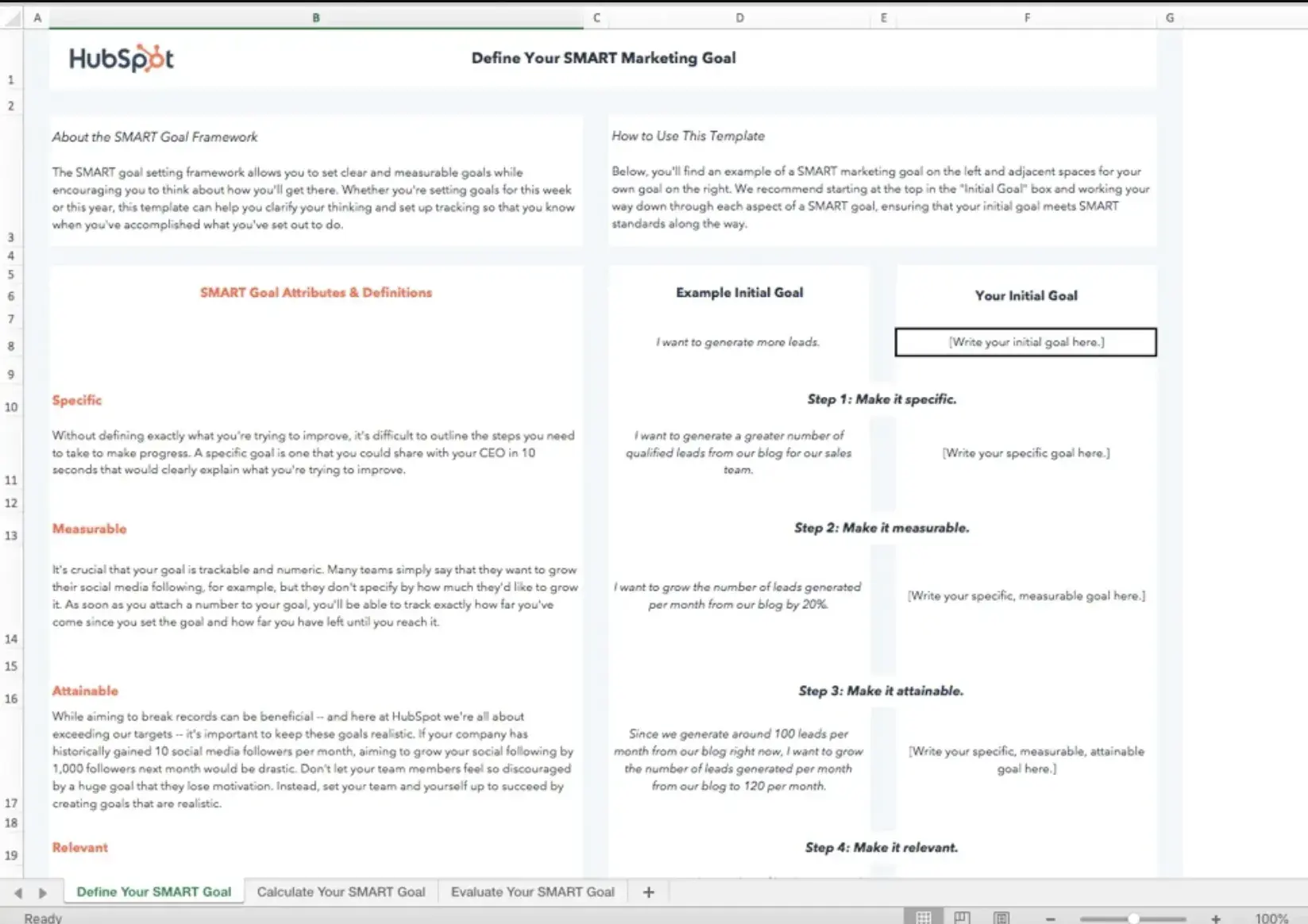
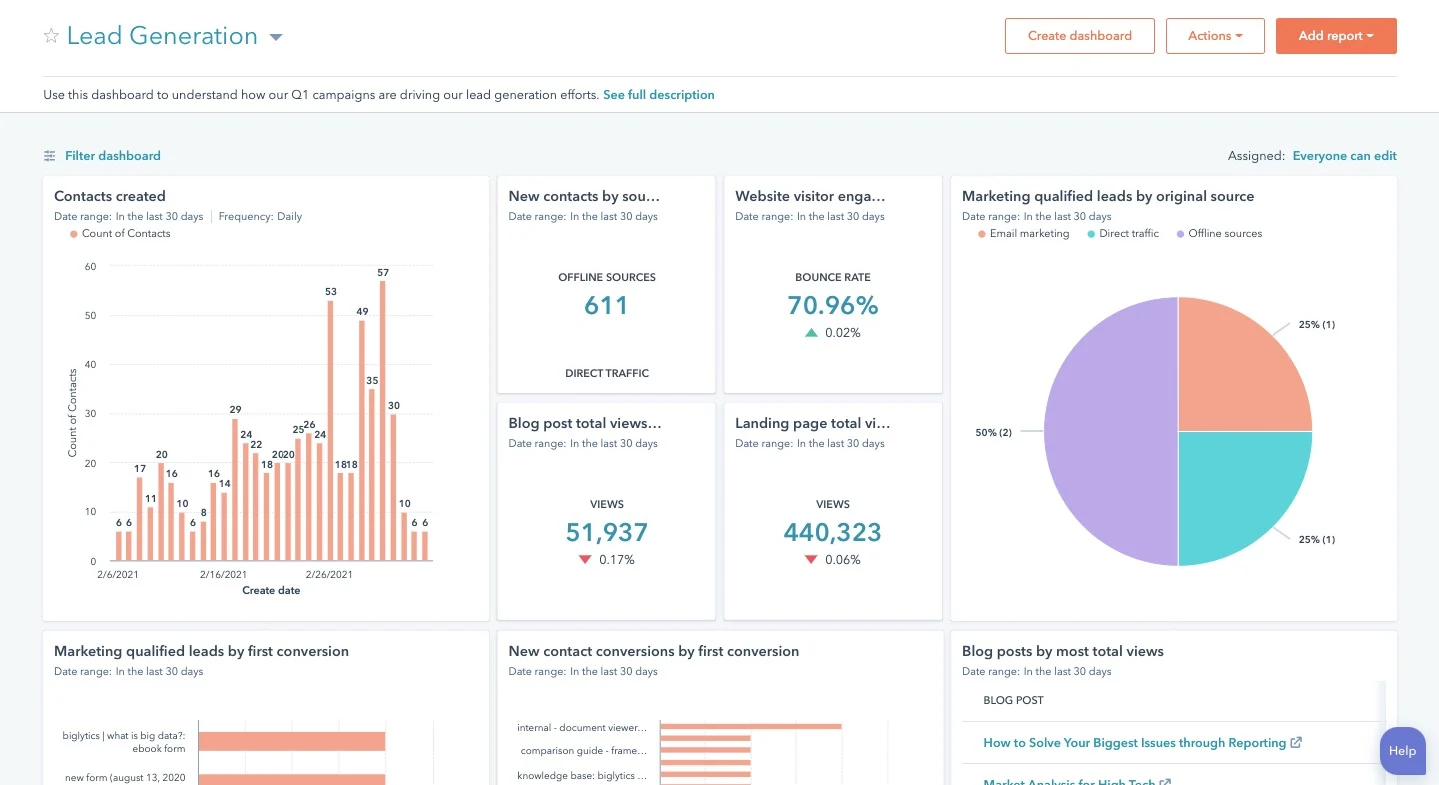
.webp?)
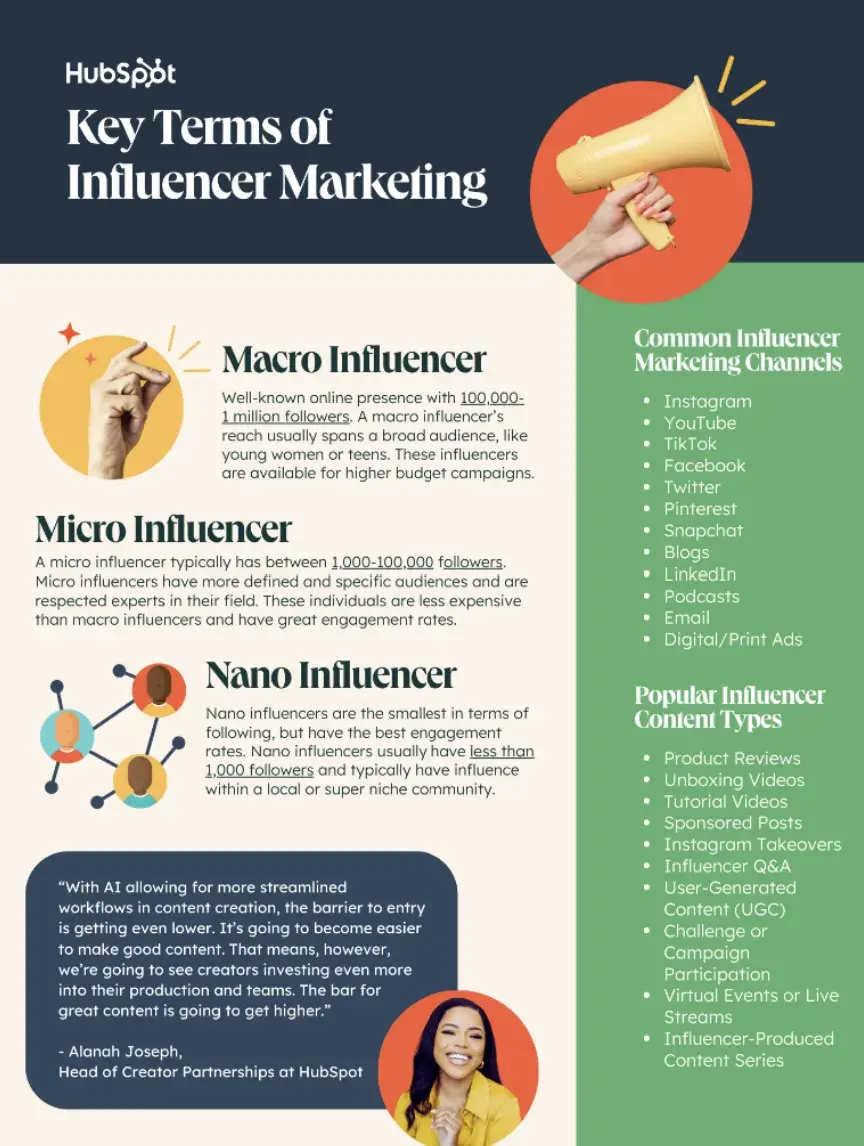



.jpg)


![Here‘s Everything I’ve Learned About Internet Marketing [Data + Expert Tips]](https://53.fs1.hubspotusercontent-na1.net/hubfs/53/internet-marketing-1-20250128-2273831.webp)

![24 Digital Marketing Tips That HubSpot Swears By [Research]](https://53.fs1.hubspotusercontent-na1.net/hubfs/53/digital-marketing-tips_0.webp)
.png)
![How Performance Marketing Works [+ 6 Tools You Can Use]](https://53.fs1.hubspotusercontent-na1.net/hubfs/53/performance%20marketing.webp)
